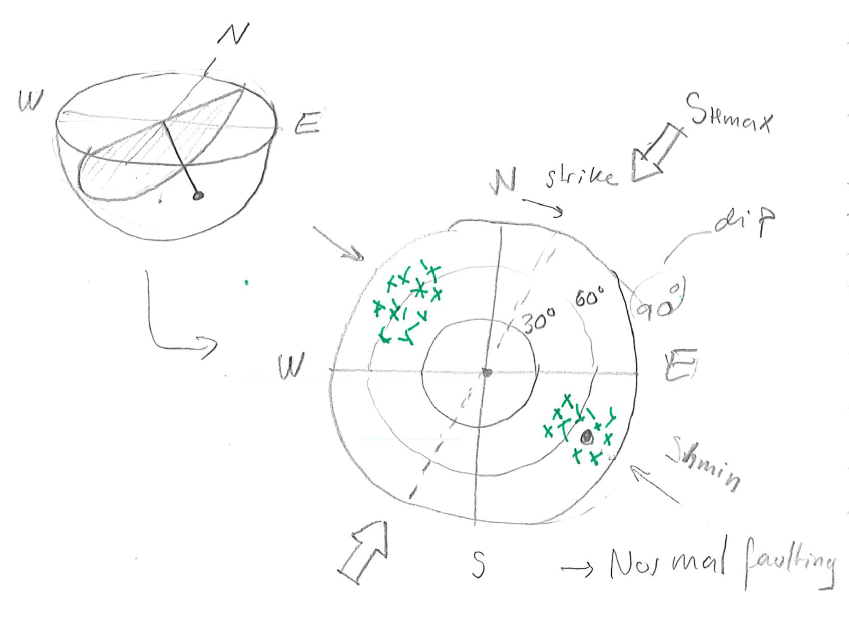Next: 5.3 Frictional strength of Up: 5. Stresses on Faults Previous: 5.1 Introduction Contents
Faults in subsurface formations are usually mapped through seismic reconstruction (see example in Fig. 5.3) and wellbore imaging.
Fig. 5.4-a shows the typical signature of fractures in a wellbore. An anomaly of electrical resistivity or ultrasonic P-wave velocity facilitates recognizing the fracture (dark pixels in the image). The reconstruction of this image (Fig. 5.4-b) helps measure fracture orientation (strike and dip - Fig. 5.4-c).
Comprehensive fracture mapping helps create 3D reservoir models that account for fault and fracture geomechanics (5.5). The magnitude of shear and normal stresses on faults and fractures depends on their orientation respect to the in-situ stress tensor.
Imagine any plane (such as the plane shown in Fig. 5.6) cutting horizontal sedimentary strata.
The strike is the line which results from the intersection of such plane and a horizontal plane.
The magnitude of the strike is the angle between the strike line and the north.
The angle of dip is the angle between a horizontal plane and the plane under consideration.
A layer is said to dip in a given direction when it gets deeper at the fastest rate into such direction.
One can think of the 
There are two conventions for reporting the magnitude of strike.
 . The quadrant convention is useful in the field. For example:
. The quadrant convention is useful in the field. For example:
 E” means 45
E” means 45 clockwise from the North towards the East
clockwise from the North towards the East
 W” means 45
W” means 45 clockwise from the South towards the West
clockwise from the South towards the West
 E” is the same as “S45
E” is the same as “S45 W” (Figure 5.7)
W” (Figure 5.7)
 measured from the North to the strike “vector” in clockwise direction (see Figure 5.23). The azimuth convention is most useful for data analytics and mathematical implementation. For example:
measured from the North to the strike “vector” in clockwise direction (see Figure 5.23). The azimuth convention is most useful for data analytics and mathematical implementation. For example:
 ” for a a fault strike N45
” for a a fault strike N45 E and dipping SE.
E and dipping SE.
 ” for a a fault strike N45
” for a a fault strike N45 E and dipping NW.
E and dipping NW.
![\includegraphics[scale=0.65]{.././Figures/split/6-StrikeConvention.PNG}](img652.svg) |
The dip is the angle between a horizontal plane and the line of maximum slope in the measured plane.
It is reported with angles between 0 and 90


Stereonets are very useful for plotting the orientation of many faults in a single 2D plot 5.8. The stereonet represents a fault plane by a dot, which is the intersection of a line normal to the fault plane and a lower hemisphere projection. Visit this website for an online animation of stereonets: https://app.visiblegeology.com/stereonetApp.html.
 |
The geological map of a single formation, say a sandy layer formation, plots the top of such formation with depth in contour lines (Fig. 5.9b). Faults can also be represented in geological maps. Normal faults are represented as thick lines with thickness proportional to the heave of the fault (Fig. 5.9c). Reverse and thrust faults (negative heave) are plotted as lines with intermittent triangles on the dipping side (Fig. 5.9d).
Strike and dip of sedimentary strata can be reported in geological maps as shown in Fig. 5.10.